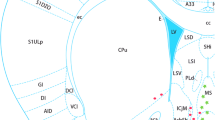Summary
The pineal gland and its major product melatonin have a key role in conveying the environmental photoperiodic stimuli that impinge upon the mammalian reproductive axis. The brain, especially the medial preoptic and suprachiasmatic areas are thought to be the main sites of melatonin's neuroendocrine activity. The responsiveness of the mammalian reproductive system to the hormone is dependent on age, on the prevailing cyclical stage and on the circadian time. The existence of specific125I-melatonin binding sites in synaptosomal fractions from rodent brain has recently been reported. The binding of125I-melatonin is inhibited by melatonin and by the novel melatonin antagonist ML-23 but not by dopamine, serotonin or other structurally related compounds. The densities of125I-melatonin binding sites at discrete brain regions vary significantly with age, circulating levels of steroid hormones or circadian time. These phenomena are compatible with the existence of melatonin receptors in the brain.
Similar content being viewed by others
References
Bittman EL, Dempsy SR Jr, Karsch FJ (1983) Pineal melatonin secretion drives the reproductive response to daylength in the ewe. Endocrinology 113: 2276–2283
Cardinali DP, Vacas MI, Boyer EE (1979) Specific binding of melatonin in bovine brain. Endocrinology 105: 437–441
Goldman BD, Carter DS, Hall VD, Roychondhury P, Yellon SM (1982) Physiology of pineal melatonin in 3 hamster species. In: Klein D (ed) Melatonin rhythm generating systems: developmental aspects. Karger, Basel, pp 290–231
Glass DT, Lynch GR (1981) Melatonin: identification of sites of antigonadal action in mouse brain. Science 214: 821–823
Glass JD, Lynch GR (1982) Diurnal rhythm of response to chronic intrahypothalamic melatonin injections in the white-footed mouse. Neuroendocrinology 35: 117–122
Lang U, Rivest RW, Schlaepfer LV, Bradtke JC, Aubert ML, Sizonenko PC (1984) Diurnal rhythm of melatonin action on sexual maturation of male rats. Neuroendocrinology 38: 261–268
Laudon M, Zisapel N (1986) Characterization of central melatonin receptors using125Imelatonin. FEBS Lett 197: 9–12
Laudon M, Zisapel N (1987) Impact of circulating estradiol on melatonin binding sites in discrete areas of the female rat brain. Brain Res 402: 146–150
Laudon M, Yaron Z, Zisapel N (1988) A-(3,5-dinitrophenyl)-5-methoxytryptamine, a novel melatonin antagonist: effects on sexual maturation of the male and female rat and on estrous cycles of the female rat. J Endocrinol 116: 43–53
Laudon M, Nir I, Zisapel N (1988 a) Melatonin receptors in discrete brain regions of mature and aged male rats: age associated decrease in receptor density and circadian rhythmicity. Submitted
Martin JE, Sattler C (1979) Developmental loss of the acute inhibitory effect of melatonin on the in vitro pituitary LH and FSH responses to LHRH. Endocrinology 105: 1007–1012
Niles LP, Wong YW, Mishra RK, Brown GM (1979) Melatonin receptors in brain. Eur J Pharmacol 55: 219–233
Reiter RJ (1980) The pineal and its hormones in the control of reproduction in mammals. Endocr Rev 1: 109–130
Reiter RJ, Petterborg LJ, Trakulrungsi C, Trakulrungsi WK (1980) Surgical removal of the olfactory bulb increases sensitivity of the reproductive system of the female rat to the inhibitory effects of late afternoon melatonin injections. J Exp Zool 212: 47–52
Tamarkin L, Baird CJ, Almeida OFX (1985) Melatonin: a coordinating signal for mammalian reproduction? Science 227: 714–720
Wurtman RJ, Axelrod J, Potter ET (1964) The uptake of3H-melatonin in endocrine and nervous tissues and effects of constant light exposure. J Pharmacol Exp Ther 143: 314–318
Zisapel N, Laudon M (1982) Dopamine release induced by electrical field stimulation of rat hypothalamus in vitro: inhibition by melatonin. Biochem Biophys Res Commun 104: 1610–1616
Zisapel N, Egozi Y, Laudon M (1982) Inhibition of dopamine release by melatonin: regional distribution in the rat brain. Brain Res 246: 161–164
Zisapel N, Egozi Y, Laudon M (1983) Inhibition by melatonin of dopamine release from rat hypothalamus in vitro: variations with sex and the estrous cycle. Neuroendocrinology 37: 41–47
Zisapel N, Egozi Y, Laudon M (1985) Circadian variations in the inhibition of dopamine release from adult and newborn rat hypothalamus by melatonin. Neuroendocrinology 40: 102–108
Zisapel N, Shaharbani M, Laudon M (1987) Regulation of melatonin's activity in the female rat brain by estradiol: effects on neurotransmitter release and on iodomelatonin binding sites. Neuroendocrinology 46: 207–216
Zisapel N, Laudon M (1987) A novel melatonin antagonist affects melatonin mediated processes in vitro and in vivo. Eur J Pharmacol 136: 259–260
Zisapel N, Nir I, Laudon M (1988) Circadian variations in melatonin binding sites and discrete areas of the male rat brain. FEBS Eett, in press
Author information
Authors and Affiliations
Rights and permissions
About this article
Cite this article
Zisapel, N. Melatonin receptors revisited. J. Neural Transmission 73, 1–5 (1988). https://doi.org/10.1007/BF01244617
Received:
Accepted:
Issue Date:
DOI: https://doi.org/10.1007/BF01244617




